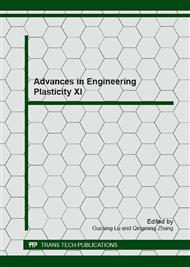p.133
p.137
p.141
p.147
p.152
p.156
p.160
p.164
p.168
Plastic Deformation Clusters with High Kinetic Energy in Metallic Glass
Abstract:
Although localized atomic rearrangements have been considered to be the underlying mechanism of plastic deformation in metallic glass, the nucleation and evolution of such plasticity events are still elusive. With the aid of molecular dynamics analysis, this study revealed that a series of localized atomic rearrangement events would occur in metallic glass as demonstrated by the formation of high-kinetic-energy clusters. It was found that atomic clusters of average sizes of 1 to 2 nm nucleate during elastic deformation, and become prevailing after yielding. The cores of these clusters contain several high-velocity atoms, which drive the local structural change and accommodate plastic strain. The nucleation and evolution of the local plasticity events are shown clearly by the strong dynamic signature, attributed to the spontaneous structural reshuffling after crossing an energy barrier.
Info:
Periodical:
Pages:
152-155
Citation:
Online since:
January 2013
Authors:
Keywords:
Price:
Сopyright:
© 2013 Trans Tech Publications Ltd. All Rights Reserved
Share:
Citation:


